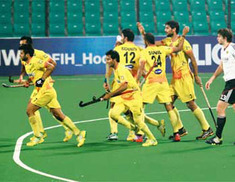
NEW DELHI - Indian hockey could not have asked for a better Diwali gift than two gold medals in the space of three weeks to set the mood for the Festival of Lights. While the 17th Asian Games gold medal at Incheon, South Korea, from the men's team was to be expected given the average opposition, the title triumph in the Sultan of Johor Cup junior tournament in Malaysia Sunday was more creditable with the Indian colts...

displaying exemplary character and aggression. The 6-2 win against Australia in Johor Cup should stand out as a new benchmark for Indian juniors who did even better by avenging league loss by defeating Britain 2-1 in the final, a couple of glaring umpiring blunders notwithstanding. Harmanpreet Singh’s two penalty corner conversions in the final were of the highest quality if only because of the speed, power and precision of the executions. Surely, the national selectors would keep a sharp eye on this young man who is still a work in progress with a bright future. Coach Harendra Singh also needs to be complimented for injecting a sense of calm and focus in the side that did not panic under pressure nor over-react to umpiring decisions that went against India, especially the second-half penalty corner that Britain converted for the equaliser.
Even more heartening was the consistent pace with which the Indian youngsters played throughout the 70 minutes in extreme humidity. There has been dramatic improvement in basic skills such as trapping and passing, though some players tended to over-indulge in dribbling when situation called for a quick release of the ball.
However, if the team were to get more balanced, then the scoring skills of the forwards require a lot of honing. There were moments in the final when the India had goal beckoning at them, but these chances went unutilised due to old failings.
Historically, Indian forwards have always been found wanting in positional play in the striking zone as also anticipation besides not taking shots at the goal at the first opportune moment. Hesitation and that wretched one last dribble rather than making an attempt gave precious fractions of a second for the opposition to regroup. Dribbling, synonymous with sub-continental hockey, is a bane and a boon in modern hockey which is founded on speed and power, and quick ball rotation using the long hits, underlining the fact that ball travels faster than man. The Indian players in Johor Cup used the dribble to great effect in deep defence and some of the stick-work bordered on magic. Conversely, the same art let the team down in attack when the ball had to be released rather than kept. These are issues for the coaches to work on, but nothing should take anything away from the triumphs in Incheon and Johor which have come not a moment too soon for Indian hockey that was down in the dumps after a string of failures, notably the 2012 London Olympics where the former monarchs were reduced to paupers who finished last.
Perhaps, it would not do any harm to include a few from the Johor team for the upcoming Test series in Australia and also the elite Champions Trophy in Bhubaneshwar in December to kick-start India’s preparations for the 2016 Olympics which should be the focus rather than immediate results. If anything, there is no dearth of talent in Indian hockey, but of greater importance is to nurture these young, enthusiastic men who have done the country proud this summer.
Even more heartening was the consistent pace with which the Indian youngsters played throughout the 70 minutes in extreme humidity. There has been dramatic improvement in basic skills such as trapping and passing, though some players tended to over-indulge in dribbling when situation called for a quick release of the ball.
However, if the team were to get more balanced, then the scoring skills of the forwards require a lot of honing. There were moments in the final when the India had goal beckoning at them, but these chances went unutilised due to old failings.
Historically, Indian forwards have always been found wanting in positional play in the striking zone as also anticipation besides not taking shots at the goal at the first opportune moment. Hesitation and that wretched one last dribble rather than making an attempt gave precious fractions of a second for the opposition to regroup. Dribbling, synonymous with sub-continental hockey, is a bane and a boon in modern hockey which is founded on speed and power, and quick ball rotation using the long hits, underlining the fact that ball travels faster than man. The Indian players in Johor Cup used the dribble to great effect in deep defence and some of the stick-work bordered on magic. Conversely, the same art let the team down in attack when the ball had to be released rather than kept. These are issues for the coaches to work on, but nothing should take anything away from the triumphs in Incheon and Johor which have come not a moment too soon for Indian hockey that was down in the dumps after a string of failures, notably the 2012 London Olympics where the former monarchs were reduced to paupers who finished last.
Perhaps, it would not do any harm to include a few from the Johor team for the upcoming Test series in Australia and also the elite Champions Trophy in Bhubaneshwar in December to kick-start India’s preparations for the 2016 Olympics which should be the focus rather than immediate results. If anything, there is no dearth of talent in Indian hockey, but of greater importance is to nurture these young, enthusiastic men who have done the country proud this summer.

 RSS Feed
RSS Feed
